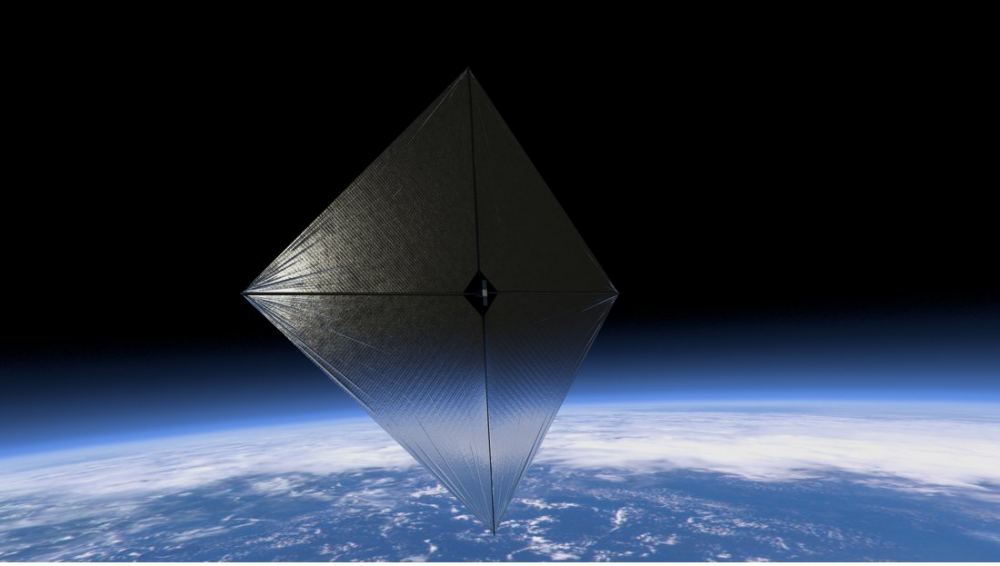Can we build an enormous umbrella to dim the Sun? Such a feat would be a megaproject on a scale like no other. It would take at least 400 dedicated rocket launches a year, for ten years (There have been 172 rocket launches by all nations so far in 2022). The project would weigh in at 550,000 tons: at its lightest. And it would be an ecological experiment that puts us all – the entire planet – in the petri dish, with high risk and high reward. But could such a project actually reverse climate change and bring us back from the brink of global disaster?
The answer seems to be yes, it could work. But there are consequences, and with the planet at stake, it seems wise to examine them before committing to such a thing.
First, let’s talk about the engineering that would make it possible. A paper by Olivia Borgue and Andreas Hein, accepted by the journal Acta Astronautica last week, describes some of the material science needed to make it a reality. The most realistic version is not one sunshade, but hundreds of small ones in a swarm.
Mass is the limiting factor for such a project, with launch costs setting the financial constraints. As such, Borgue and Hein propose an ultra-light material, made of thin film and silicon dioxide nanotubes. The shades would have a “transparent refractive surface” to redirect the sunlight.
For this to work, you don’t really want to create a solar sail that is pushed out of the way by the Sun’s radiation pressure – you want the shade to be able to maintain its position. So this design seeks to minimize the radiation pressure on the shade, redirecting rather than stopping sunlight.
The swarm would be positioned at the L1 Lagrange point between the Earth and the Sun. It would only need to block between 2 and 4 percent of the Sun’s light to bring Earth’s temperatures back to pre-industrial levels.
If we wanted, the authors deem that the necessary technology is achievable within 15 years.
But do we want to?
If it fixes climate change, then maybe, but there are good arguments against mega geoengineering projects like this. Two are particularly compelling.
The first is that the risks may be too high, and there are too many unknowns. Simulations do their best to predict outcomes (and researchers have carried out climate simulations on this very idea), but they aren’t perfect. What’s more, even the known consequences aren’t all positive. While temperatures would be brought back to sustainable levels, it would also cause a global reduction in rainfall of 5%. That means fewer floods (good news for low-lying countries threatened by climate change), but also more drought in arid regions. In other words, geoengineering has winners and losers: who gets to decide who is who?
The solar sail model, to its credit, is capable of being dismantled if things go wrong. There are more permanent versions of this idea. A Harvard study called SCoPEx is testing the notion of releasing particulates of sulfuric acid into the upper atmosphere, lowering global temperatures similar to the way large volcanic eruptions does. These particulates can be harmful to the ozone layer, so the team is searching for less damaging alternatives, like calcium carbonate. It’s clever, but messing with the atmosphere is something you don’t want to get wrong.

The answer to this particular criticism – that solar geoengineering is too risky – is countered by the argument that climate change is worse. And if we continue on the path we are currently taking, that may someday be true.
But the second, and perhaps more important criticism of such a mega project, is that it misses the point. Humanity needs to find ways to slow the consumption of resources and reduce emissions, not find ways to enable our addiction. If sunshades work, they become an easy excuse to pump more fossil fuels, while reducing the urgency to build resilient renewable technologies. It’s a crutch, not a cure.
It’s likely this isn’t the last we’ll hear of solar geoengineering projects. There are other similar studies in the works. And, as proponents rightly argue, there is value in research like the SCoPEx study and the Borgue/Hein paper. The discovery of novel lightweight materials, more accurate modeling of climate systems, and deeper understandings of atmospheric chemistry: all of these are undeniably a net good. As a last resort, a geoengineering megaproject may even ultimately save us from ourselves. But it also feels a bit like giving up. Climate change is a policy problem as much as a technological one, and in much of the world, policy is the lagging variable. Technology won’t need to save us if policy changes can.
The Sun didn’t get us into this mess, we did. Let’s get ourselves out of it.
Learn More:
Olivia Borgue and Andreas Hein, “Transparent occulters: A nearly zero-radiation pressure sunshade to support climate change mitigation.” Acta Astronautica.
SCoPEx, Harvard University.
Evan Gough, “We Have the Technology. Airplanes Could Spray Particles into the Atmosphere to Battle Climate Change. But Should We?“
Paul M. Sutter, “MIT Researchers Propose Space Bubbles to Stop Climate Change.”
Featured Image: An artist’s concept of a solar sail. Credit: NASA.

